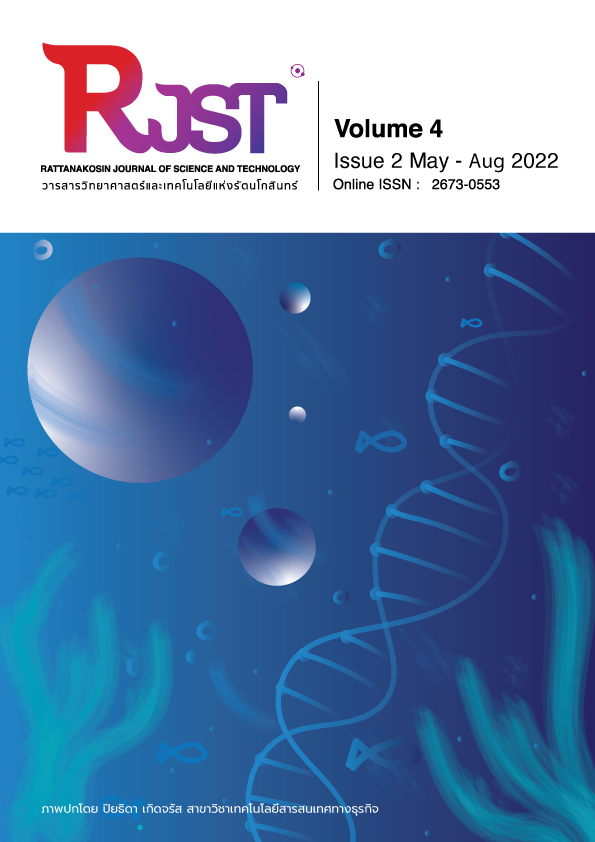Development of a pavement sub base compaction from rubber latex sludge mixed cement and newspaper for adding value waste from latex factory
Main Article Content
Abstract
This research is to study Sub Base Compaction from Rubber Latex Sludge Mixed Cement and Newspaper for Adding value Waste from Latex Factory. The results showed that, from the design of 5 formulas, the materials Rubber cake pulp: Cement: Paper at ratio 934: 100: 50 (kg) has the best CBR when considering the suitability for use in different ways. It was found to be at a fair level in material handling. Because of the rubber dough residue, it is a lightweight material (Department of Highways) when mixed with cement and paper to improve its engineering properties. It was found to be more likely to be used to improve the stability of the itch and to reduce the collapse. When the paper is mixed with the cementitious us pulp in the ratio of 10, 25 and 50 kg, respectively, it will increase the capacity (CBR.) To increase from 0.99 to 3.90% according to the amount of paper. Added the rate of swelling decreases when the rubber granules are removed with cement and newspaper.
Article Details

This work is licensed under a Creative Commons Attribution-NonCommercial-NoDerivatives 4.0 International License.
The content within the published articles, including images and tables, is copyrighted by Rajamangala University of Technology Rattanakosin. Any use of the article's content, text, ideas, images, or tables for commercial purposes in various formats requires permission from the journal's editorial board.
Rajamangala University of Technology Rattanakosin permits the use and dissemination of article files under the condition that proper attribution to the journal is provided and the content is not used for commercial purposes.
The opinions and views expressed in the articles are solely those of the respective authors and are not associated with Rajamangala University of Technology Rattanakosin or other faculty members in the university. The authors bear full responsibility for the content of their articles, including any errors, and are responsible for the content and editorial review. The editorial board is not responsible for the content or views expressed in the articles.
References
กรมโรงงานอุตสาหกรรม. (2552). คู่มือการกำกับดูแลโรงงาน : อุตสาหกรรมที่มีกระบวนการรีด บด ผสมยาง.
บริษัท ปัญญา คอนซัลแทนท์ จำกัด. กรุงเทพฯ.
คณะอนุกรรมการคอนกรีตและวัสดุ, คณะกรรมการวิชาการสาขาวิศวกรรมโยธา. (2562). ข้อกำหนด
มาตรฐานวัสดุและการก่อสร้างสำหรับโครงสร้างคอนกรีต. วิศวกรรมสถานแห่งประเทศไทยในพระบรม
ราชูปถัมภ์. กรุงเทพฯ.
คุลยา ศรีโยม. (2556). แผนธุรกิจผลิตภัณฑ์อิฐดินเผาน้ำหนักเบาจากกากขี้แป้งยางพารา (Business Plan of Lightweight Baked Clay Product from Concentrated LatexIndustry Waste Residue). การประชุมหาดใหญ่วิชาการ ครั้งที่ 4.
พิศุทธุ์ ศิริพันธุ์, จิรศักดิ์ จินดาโรจน์และทรงกลด จารุสมบัติ. (2557). กากขี้แป้งยางของเสียจากโรงงาน
สู่ผลิตภัณฑ์ที่เป็นมิตรต่อสิ่งแวดล้อมโดยการมีส่วนร่วมของชุมชน. วารสารการจัดการป่าไม้ 8(16) : 53-63.
ภิรมย์ขวัญ ชิณวงศ์ เกริกชัย ธนรักษ์ และอรวรรณ ศิริรัตน์พิริยะ (2557). ผลของการใช้กากขี้แป้งเป็นแหล่งแมกนีเซียมเพื่อการเติบโตของปาล์มน้ำมันระยะอนุบาลหลัก. การประชุมวิชาการเสนอผลงานวิจัยระดับบัณฑิตศึกษา ครั้งที่ 15. 776-782.
วัชราพร ป้องก่าน. (2551). โครงการนำของเสียกากขี้แป้งจากโรงงานอุตสาหกรรมการผลิตน้ำยางข้นไปเป็นส่วนประกอบในวัสดุก่อสร้าง. โครงงานวิศวกรรมสิ่งแวดล้อม ภาควิชาวิศวกรรมโยธา คณะวิศวกรรมศาสตร์ มหาวิทยาลัยสงขลานครินทร์
วีรยา ฉิมอ้อย และ ศิรวิทย์ นะวะยศ (2553). พฤติกรรมของดินทรายที่มีขนาดคละไม่ดี เมื่อปรับปรุงด้วยซีเมนต์
สำหรับงานทาง (Behavior of Poorly Graded Sand Stabilized with Cement For Road Construction).
ภาควิชาวิศวกรรมโยธา คณะวิศวกรรมศาสตร์ มหาวิทยาลัยธรรมศาสตร์.
สถิตย์ ชินอ่อน (2556). คุณสมบัติการบดอัดและค่าซีบีอาร์ของดินถมคันทาง. ปริญญานิพนธ์มหาบัณฑิต. มหาวิทยาลัยเทคโนโลยีสุรนารี.
เสาวนีย์ ก่อวุฒิกุลรังษี, สมพร ประเสริฐส่งสกุลและยุพดี ชัยสุขสันต์. (2558). นวัตกรรมการลดกลิ่นกาก
ขี้แป้งน้ำยาง. วารสารวิชาการเทคโนโลยีพลังงานและสิ่งแวดล้อม (Journal of Energy and Environment Technology).2(2) : 42-54.
อาวุธ โพธิ์อุดม และคณะ (2553). การศึกษาประเมินความแข็งแรงของวัสดุผิวทางเดินปรับปรุงคุณสมบัติทางด้านวิศวกรรมด้วยซีเมนต์ปอร์ตแลนด์บดอัดแน่น. วิศวกรรมสารมหาวิทยาลัยเกษตรศาสตร์. ISSN:
-9317.
Lee, P. Y., and Suedkamp, R. J., (1972) “Characteri stics of Irregularly Shaped Compaction Curves., “1st Annual Meetin of Hi hwa Research Board, National Research Counci l, to be Published in HRB Bulletin).
Suksun H., Chayakrit P., Avirut C. and Arnon C., (2005). Strength development in silty clay stabilized with calcium carbide residue and fly ash. Soils and Foundations. Volume 53, Issue 4, August 2013, Pages 477-486.


